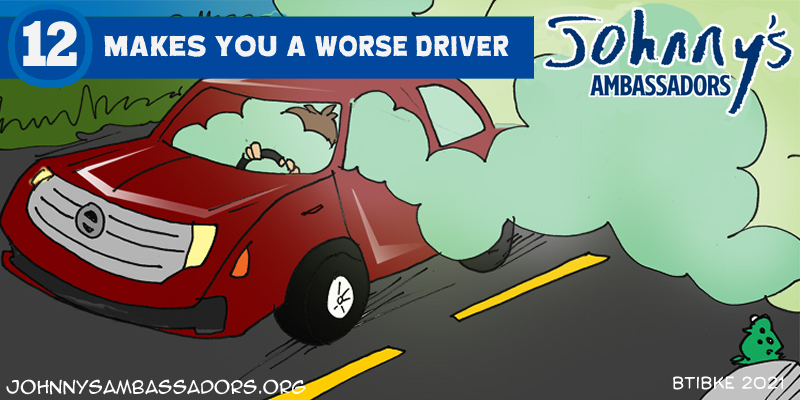By Laura Stack
Today, tens of thousands of people die annually in auto accidents in the United States alone. Intoxicated drivers cause about one-third of those deaths. For decades, alcohol was the predominant intoxicant of choice, but drugged driving, driving under the influence of other drugs, alone, or in combination with alcohol, has become increasingly more common. However, intoxicant-related statistics to deaths involving marijuana intoxication aren’t always broken out. Additionally, traffic officers aren’t always trained to recognize the difference between alcohol and marijuana intoxication.
Regrettably, until recent years, neither users nor most authorities took marijuana seriously as a contributor to traffic accidents and fatalities. As a society, we’re now starting to learn our lesson, as it’s become increasingly obvious that modern marijuana greatly impairs a user’s ability to drive as any other intoxicant. Whoever believes they can drive better while under the influence of a mind-altering substance is fooling themselves.
Now that marijuana has been legalized or decriminalized in many states, law officers have had to deal with stoned drivers more and more often, as outlined in a crucial 2017 report to Congress. Five years later, there’s still no standard, validated field test for determining THC content in a person’s bloodstream, as there is for Blood Alcohol Content (BAC). However, traffic officers use field coordination tests to recognize stoned drivers and tests such as asking offenders to say the alphabet backward from a letter in the middle.
What makes stoned driving so dangerous? We now know marijuana intoxication dulls the abilities to:
- Assess risks
- Plan routes
- Make quick decisions
- Brake suddenly
- Drive straight
- Pay attention to multiple things (the road, traffic, mirrors)
While we’ve made good progress with public service efforts to drive down alcohol-related deaths, traffic deaths peaked in the first nine months of 2021, after dropping significantly from 1980-2019. The article says, “Distracted driving, drowsy driving, drunk driving, speeding and not wearing a safety belt continue to be the leading factors in these otherwise preventable crashes,” but it doesn’t mention drugged driving. But at the height of COVID, when mental illness was at a peak, I suspect some of it has been due to increased use of highly potent modern marijuana.
It’s time to get serious about getting the message out there that driving stoned is just as unacceptable as driving drunk.



Thank you.
THERE DO EXIST TECHNOLOGY to determine impairment to drive with marijuana. IMMAD is such a technology. However the FDA requires clinical studies before technologies can be marketed to law enforcement. Such studies are illegal in the US.
If these barriers were eliminated, products would be available for officers to obtain objective information on impairment.
The DRE process will remain the best option but marijuana proponents–protecting the rights of marijuana impaired drivers, have been successful in eliminating the courtroom testimony and opinion of such experts in at least two states with legal adult use marijuana.
Validating the DRE process even further is essential.
1 A crash caused by an impaired driver is a crime, NOT an accident. The word accident is preferred by defense attorneys to deflect culpability from their clients. We don’t charge, fine or incarcerate people for accidents, only for crimes. A neutral word is crash, or collision if the cause is not know. Calling a crash an accident presupposes that it was not a crime.
2 You claim there is no standard validated field test for determining the level of THC in a person’s bloodstream. Your statement is correct, but it suggests to people that future developments can result in a device to determine THC content in a person’s bloodstream. We have oral fluid devices that confirm the presence of THC, but not its quantitative level. No one is working a roadside quantitative THC level technology that I know of, simply because it would be meaningless. You see, unlike for alcohol, there is no correlation between a blood THC level and the level of impairment.
A more useful statement is, “Because of the poor correlation between blood THC levels and levels of impairment, courts rely upon the results of field sobriety tests conducted by trained officers to convict drivers of drugged driving.”
A few years ago, while attending the Community Anti-Drug Coalitions of America (CADCA) Mid-Year Conference, I was introduced to one of the first Drug Recognition Expert (DRE) officers. “A DRE is a police officer specially trained in recognizing specific symptoms and behaviors that are caused by drugs”.
Further the DRE can determine if the impairment is caused by alcohol, drugs or a combination of both. These conditions may require medical attention. Both urine and blood samples are analyzed for drug type. Through the DRE Training of police officers law enforcement has the means of identifying drug impaired drivers and collect evidence to prosecute them as well.
From the Office of Justice Programs U.S. Department of Justice website.